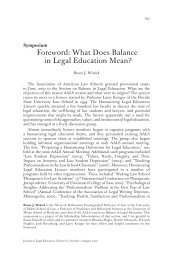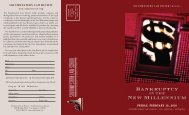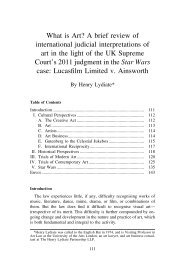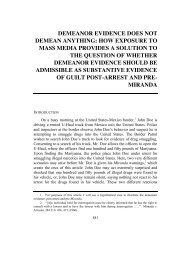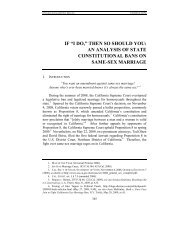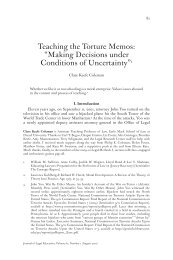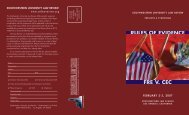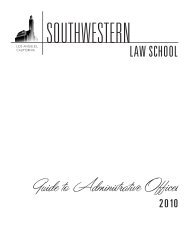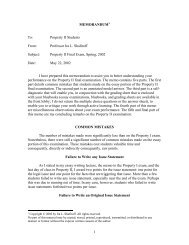An Autobiography of a Digital Idea - Southwestern Law School
An Autobiography of a Digital Idea - Southwestern Law School
An Autobiography of a Digital Idea - Southwestern Law School
Create successful ePaper yourself
Turn your PDF publications into a flip-book with our unique Google optimized e-Paper software.
<strong>An</strong> <strong>Autobiography</strong> <strong>of</strong> a <strong>Digital</strong> <strong>Idea</strong><br />
491<br />
formulate their own opinions and drive the discussion themselves. They enjoy<br />
learning through discovery and discussion. 39 Their collaboration can either be<br />
in class, in person or virtual. 40 As a result, the pr<strong>of</strong>essor no longer needs to be<br />
the sole and center point <strong>of</strong> learning; instead students have many resources<br />
from which to choose. <strong>Digital</strong> students <strong>of</strong>ten set up blogs for specific issues.<br />
They also e-mail and IM each other <strong>of</strong>ten (usually in the middle <strong>of</strong> class).<br />
E. Immediate Feedback<br />
<strong>Digital</strong> students demand immediate feedback. Video games are especially<br />
adept at providing this because players can see the result <strong>of</strong> their actions<br />
immediately. 41 As an activity progresses, digital students also benefit from<br />
interactive materials that provide continuing feedback. Quizzes, selfassessments<br />
and tutorials are useful tools for these students because they<br />
immediately receive an answer, a score, or a response <strong>of</strong> some sort. Feedback<br />
need not come directly from a pr<strong>of</strong>essor. It can come from online resources,<br />
peers, and blogs, and other online tools.<br />
F. Convenience<br />
<strong>Digital</strong> students demand convenience. They are so accustomed to getting<br />
their information instantly at the touch <strong>of</strong> the keyboard that they become<br />
frustrated easily by wasting time looking for materials, relying on books in<br />
distant libraries, or even scrolling for too long on a computer screen. Ondemand<br />
cable, TIVO, the twenty-four‐hour availability <strong>of</strong> the Internet and<br />
the ability to use cell phones to communicate at any time or location has made<br />
these students an instant-information generation.<br />
In sum, I have found that digital students, like students <strong>of</strong> all generations,<br />
need to be engaged to learn. 42 However, unlike other generations <strong>of</strong> learners,<br />
digital students become engaged by using computers as vehicles for threedimensional,<br />
discovery-based learning. They learn from multitasking<br />
and telescoping, powering up in the classroom, engaging in peer review<br />
and collaboration, and receiving immediate feedback—all in a convenient<br />
environment that stimulates active learning. “Active learning facilitates longterm<br />
memory” 43 and allows students to develop their own creativity and<br />
thought process. As a result, students feel as if they have more control over<br />
39. See id.<br />
40. See Carlson, supra note 5.<br />
41. For more on video game learning, see Marc Prensky, <strong>Digital</strong> Game-Based Learning<br />
(McGraw Hill 2000); see also Marc Prensky, Don’t Bother Me Mom, I’m Learning (Paragon<br />
House 2006).<br />
42. McGlynn, supra note 23.<br />
43. See id.; for more on “active, critical learning theory” see James Paul Gee, What Video Games<br />
Have to Teach Us about Learning and Literacy (Palgrave Macmillan 2003).




